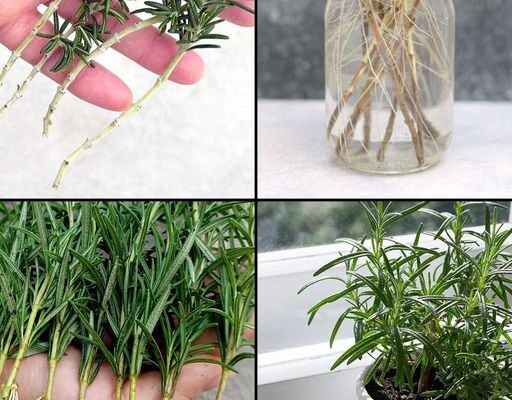Rosemary is a versatile and aromatic herb that adds a delightful flavor to many dishes. Growing rosemary at home is not only convenient but also ensures that you always have fresh rosemary at your fingertips. One of the easiest ways to propagate rosemary is by using cuttings. In this article, we’ll guide you through the process of growing rosemary from cuttings in water and then transplanting them into pots so that you can enjoy a constant supply of this fragrant herb in your kitchen.
Materials You’ll Need:
- Healthy rosemary plant
- Clean pruning shears or scissors
- Glass or vase
- Distilled or filtered water
- Rooting hormone (optional)
- Small pots with drainage holes
- Well-draining potting mix
- Plastic bags or plastic wrap
- Rubber bands or twine
- Sunlight or grow lights

Step 1: Gather Rosemary Cuttings
Choose a healthy and mature rosemary plant for your cuttings. Select stems that are free from diseases or pests, and make your cut just below a leaf node. Each cutting should be approximately 4-6 inches long.
Step 2: Prepare Cuttings
Trim the leaves from the lower 2-3 inches of the cuttings, leaving only a few leaves at the top. This will help reduce moisture loss during the propagation process.
Step 3: Rooting Hormone (Optional)
Although not mandatory, using a rooting hormone can enhance the success rate of your cuttings. Dip the cut end of each cutting into a powdered or gel rooting hormone. Shake off any excess.
Step 4: Place Cuttings in Water

Fill a glass or vase with about 2-3 inches of distilled or filtered water. Place your rosemary cuttings into the water so that the cut ends are submerged. Be sure to change the water every few days to keep it fresh.
Step 5: Maintain Humidity
To create a humid environment for your cuttings, cover the glass or vase with a plastic bag or plastic wrap. Secure it with a rubber band or twine. This will help prevent moisture loss and encourage root development.
Step 6: Provide Adequate Light
Place the container with cuttings in a location that receives indirect sunlight. You can also use grow lights if natural light is insufficient. Avoid exposing the cuttings to harsh, direct sunlight as it can cause excessive drying.
Step 7: Monitor and Wait
Check the water level regularly, and ensure that the cuttings remain submerged. You should start to see roots forming in about 2-6 weeks. Once the roots are about 2-3 inches long, the cuttings are ready for transplanting.
Step 8: Transplant into Pots
Choose small pots with drainage holes and fill them with a well-draining potting mix. Carefully remove the cuttings from the water, taking care not to damage the delicate roots. Plant each cutting in a pot, burying it about 1-2 inches deep.
Step 9: Water and Care
Water the newly transplanted rosemary cuttings thoroughly, and place the pots in a sunny location. Water the plants when the top inch of soil feels dry. Be sure to provide good airflow to prevent diseases.
Step 10: Enjoy Fresh Rosemary
With proper care, your rosemary cuttings will grow into healthy plants. As they mature, you can harvest fresh rosemary whenever you need it for your culinary delights.

Growing rosemary from cuttings in water and transplanting them into pots is a straightforward and rewarding process. With a bit of patience and care, you can ensure a constant supply of fresh rosemary right in your kitchen. This aromatic herb will not only enhance the flavors of your dishes but also add a touch of greenery to your home. Happy gardening!



